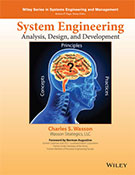Table of Contents
Introduction
- 1. Systems, Engineering, and Systems Engineering
- 2. The Evolving State of SE Practice-Challenges and Opportunities
Part 1 System Engineering and Analysis Concepts
Part 1 provides the foundation for understanding how systems, products, and services are organized, structured, characterized, and modeled. Chapters include:
- 3. System Attributes, Properties, and Characteristics
- 4. User Enterprise Roles, Missions, and System Applications
- 5. User Needs, Mission Analysis, Use Cases, and Scenarios
- 6. System Concepts Formulation and Development
- 7. System Command and Control (C2) - Phases, Modes, and States of Operation
- 8. System Levels of Abstraction, Semantics, and Elements
- 9. Architectural Frameworks of the SOI and Its Operating Environment
- 10. Modeling Mission System and Enabling System Operations
- 11. Analytical Problem-Solving and Solution Development Synthesis
Part 2 Systems Engineering and Development Practices
Part 2 builds on the foundation presented in Part 1 and addresses key strategies, practices, and principles for designing and developing systems, products, and services. Chapters include:
- 12. Introduction to System Development Strategies
- 13. System Verification and Validation (V&V) Strategy
- 14. The Wasson Systems Engineering Process
- 15. System Development Process Models
- 16. System Configuration Identification and Component Selection Strategy
- 17. System Documentation Strategy
- 18. Technical Reviews Strategy
System Specification Practices
- 19. System Specification Concepts
- 20. Specification Development Approaches
- 21. Requirements Derivation, Allocation, Flow Down, and Traceability
- 22. Requirements Statement Development
- 23. Specification Analysis
System Development Practices
- 24. User-Centered System Design (UCSD)
- 25. Engineering Standards of Units, Coordinate Systems, and Conventions
- 26. System and Entity Architecture Development
- 27. System Interface Definition, Analysis, Design, and Control
- 28. System Integration, Test, and Evaluation (SITE)
- 29. System Deployment, OM&S, Retirement, and Disposal
PART 3 ANALYTICAL DECISION SUPPORT PRACTICES
Part 3 provides analytical practices that support Parts 1 concepts and Part 2 development practices. Chapters include:
- 30. Introduction to Analytical Decision Support
- 31. System Performance Analysis, Budgets, and Safety Margins
- 32. Trade Study Analysis of Alternatives (AoA)
- 33. System Modeling and Simulation (M&S)
- 34. System Reliability, Maintainability, and Availability (RMA)
Epilog
Appendices
Appendix A Acronyms and Abbreviations
Appendix B INCOSE Handbook Traceability
Appendix C System Modeling Language (SysML™) Constructs

